
Sentiment Analysis & Billboard Top 100: The Changing Mood of Popular Music .
We used sentiment analysis to model 5100 Billboard chart-toppers between 1964 and 2015. Our analysis predicted whether song lyrics were positive, negative or neutral as well as detecting the topic and intent behind the most popular tunes in music history.
"Hot summer streets and the pavements are burning, I sit around trying to smile but the air is so heavy".
So goes the opening lines of "Cruel Summer", a 1998 single from Swedish pop group Ace of Base. Far from the band's most popular release, the track hit 68 in the Billboard top 100. But though it might be lost to the annals of pop music history, the sentiment captured in the song tells of a culture shift in popular music that was quickening in pace around the turn of the millennium.
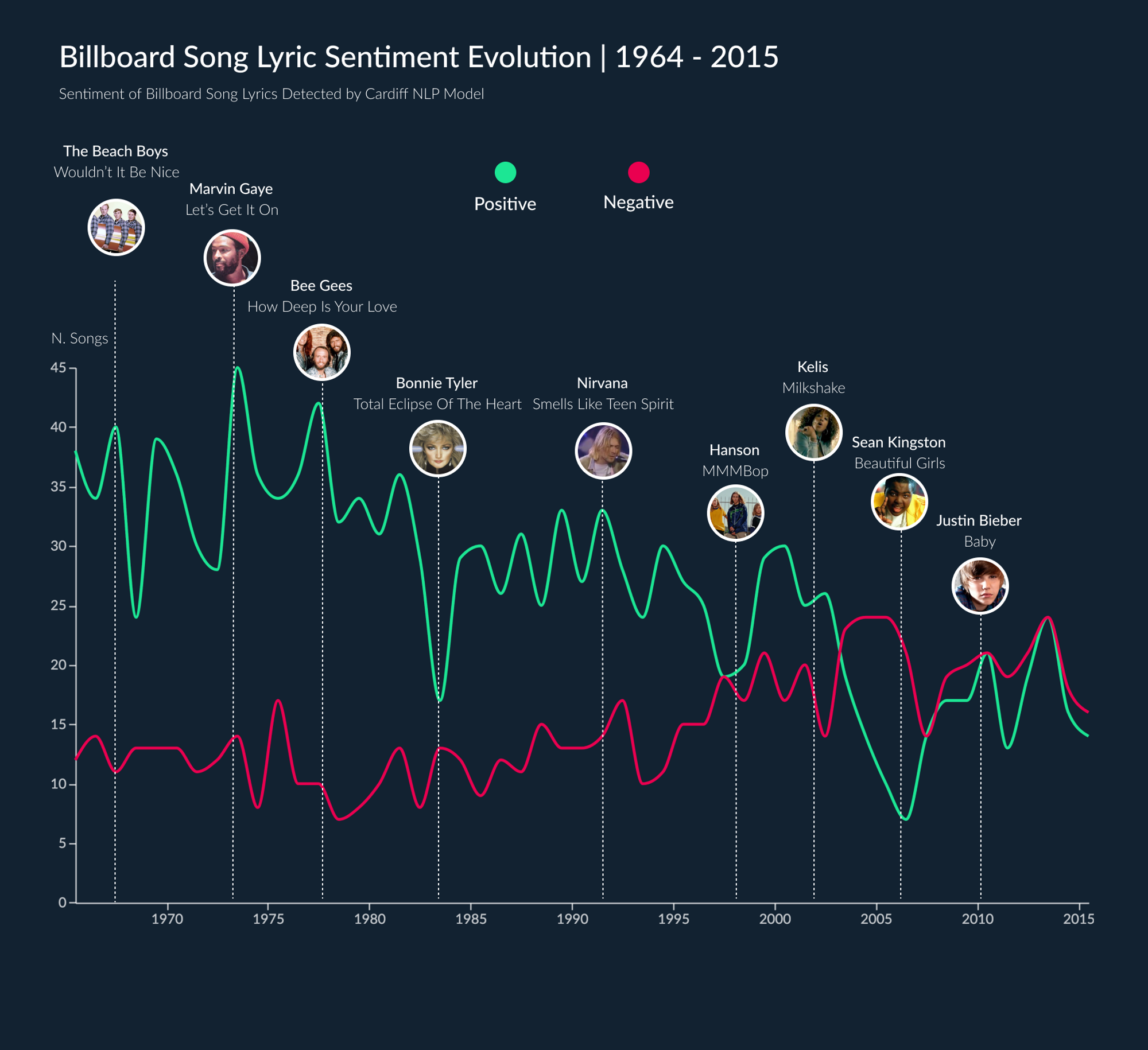
Song lyrics are becoming less positive and more negative. We used a Hugging Face | Cardiff NLP sentiment analysis model to study the song lyrics of annual Billboard Top 100 hits between 1964 and 2015. Between 1965 and 1975, the chart averaged 12 songs each year classified as negative and 38 classified as positive. The same average between 2005 and 2015 is dramatically different - only 15 songs classified as positive and 20 negative.
What's happened to music? Is it language evolution - better representation of everyday people - are our models wrong or is this shift in sentiment generally indicative of modern society's mood?
"I've got sunshine on a cloudy day. When it's cold outside I've got the month of May."The Temptations - My Girl | 1965
Analyzing the Sentiment of Song Lyrics
It's worth taking a moment to talk about how we came up with our findings. Sentiment analysis models are predictive. This means that they get trained on data that has been labelled as either positive, negative or neutral and are able to make predictions about whether new data is positive, negative or neutral based on its training.
In our dataset, each row represents one song from the annual Billboard Top 100 charts. Each row contains the song name, the artist, a Billboard rank and all of the lyrics in the song. So when we deployed our sentiment analysis model - it analysed the full lyrics of a song and came up with a positive, negative or neutral prediction for that song.
"I love the colorful clothes she wears and the way the sunlight plays upon her hair. I hear the sound of a gentle word on the wind that lifts her perfume through the air. I'm pickin' up good vibrations."The Beach Boys - Good Vibrations | 1966
If you want to perform a similar sentiment analysis of text - check the HOW TO - at the bottom of the article.If you want to perform a similar sentiment analysis of text - check the HOW TO - at the bottom of the article.
Music's Most Negative Artists
Of all the 2473 unique artists that have secured a spot in Billboard history, some - more than others - have built their success on negative song lyrics. Here are our top 3 negative artists.
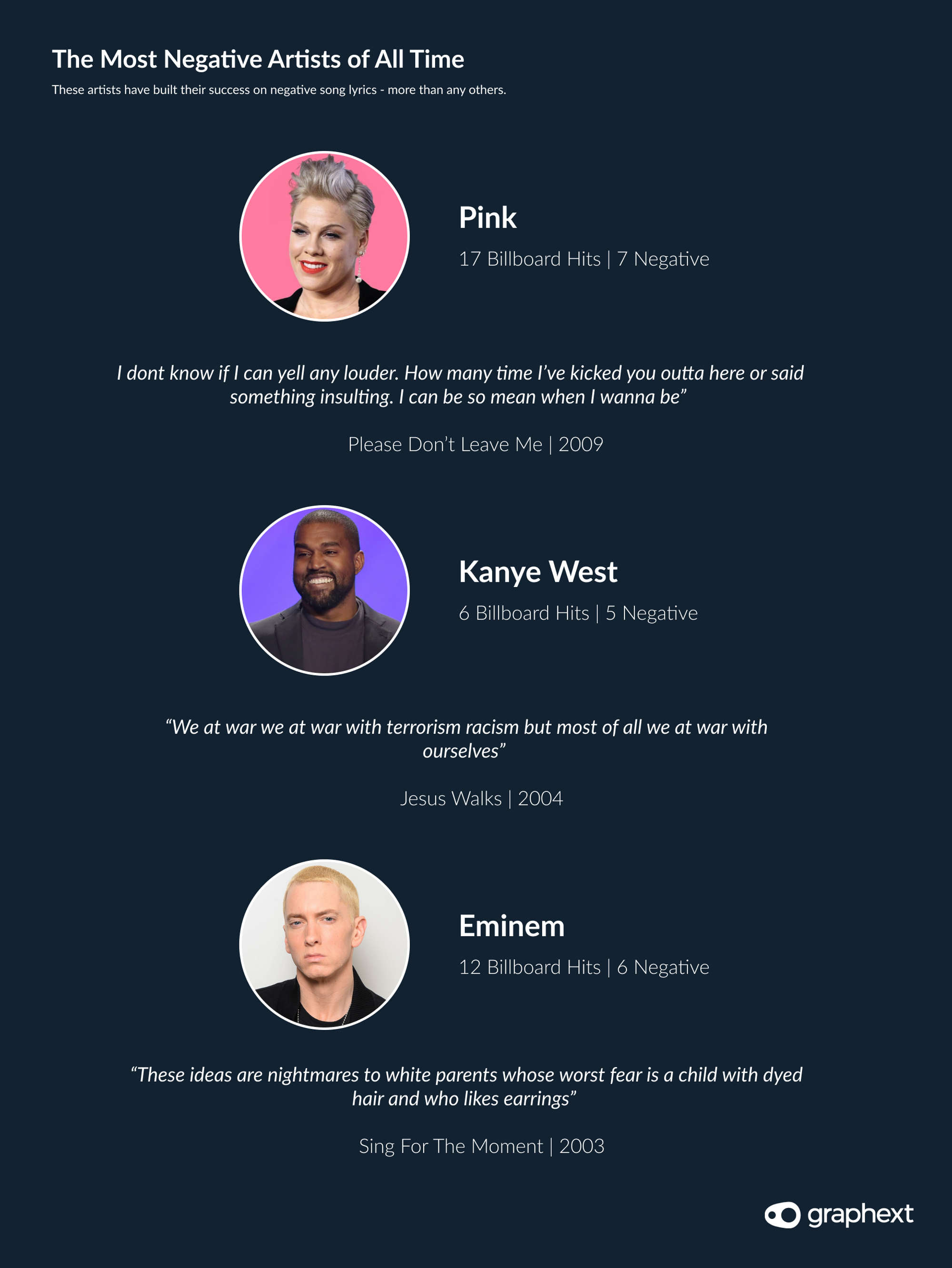
The most negative artists of all time.
Music's Most Positive Artists
Other artists have made a habit of spreading positivity through their song lyrics. Here are our top 3 positive artists of all time. A special mention to Lionel Richie for making two appearances.
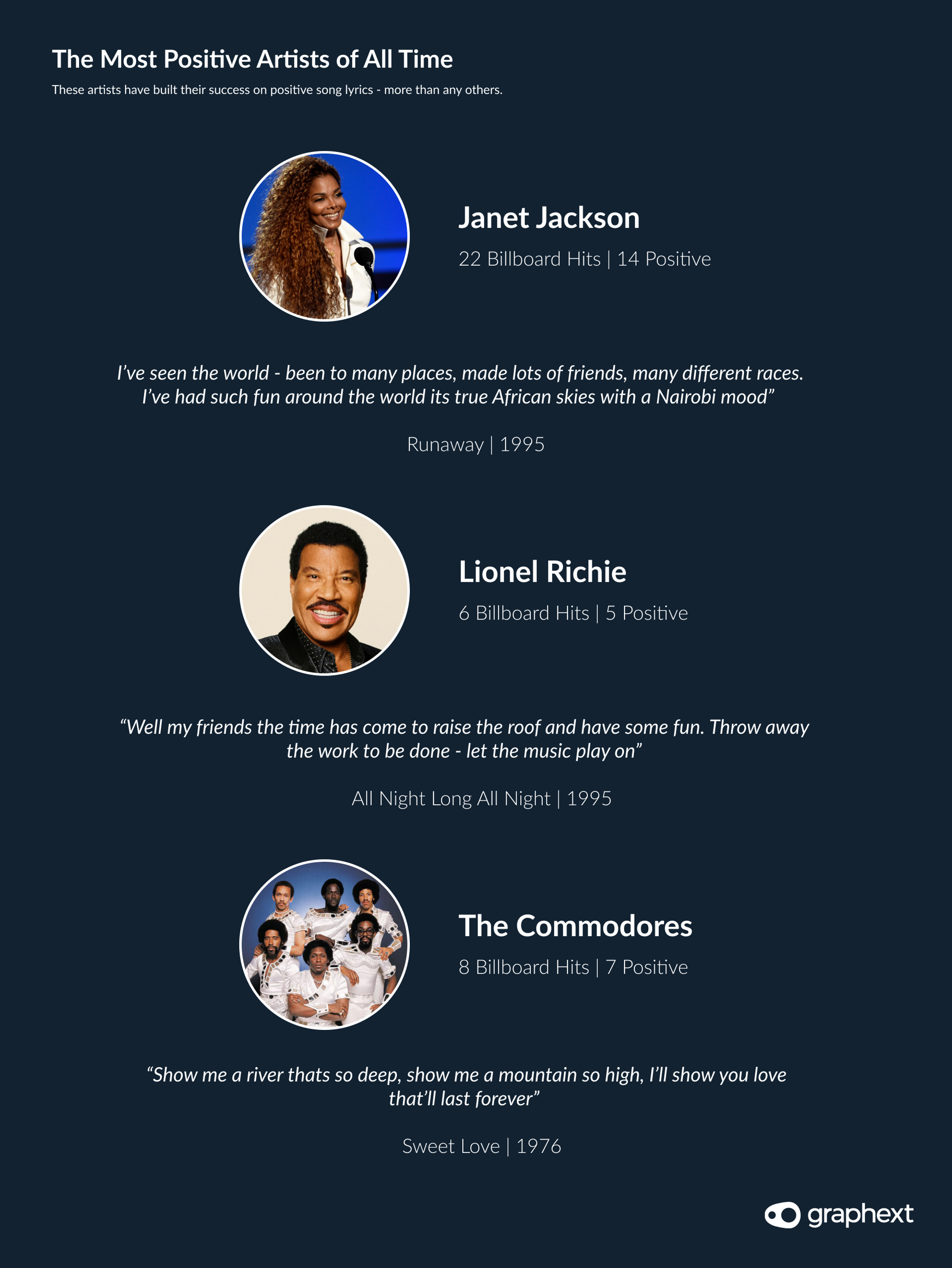
The most positive artists of all time.
Why Are Songs Becoming More Negative?
The trend lines point towards a seismic shift in the sentiment of song lyrics. Positive songs have been in steady decline since the mid 70's and negative ones have gradually increased since the 90's. But there is a clear crossover point in the early 00's. What changed in the content of song lyrics around this time to make our model classify more of them as negative?
Using TF-IDF to sort the significant terms in song lyrics, we narrowed our focus to look closely at the difference in negative song lyrics between generations.
Negative Songs | 1965 - 1975
Music fans of today might describe some of the negative n-grams (significant terms) of billboard song lyrics of old as a little on the tame side. "Cry" we'd assume belongs in the bracket of lonesome ballads as does "lonely", which appears in almost 10% of songs in this category.
Heartache doctors like Elton John and Cher proliferate here. Mark the notable absence of swear words!
"Set me free why don't cha babe. Get out my life why don't cha babe. Cause you don't really love me, you just keep me hangin' on."The Supremes - You Keep Me Hanging On | 1966
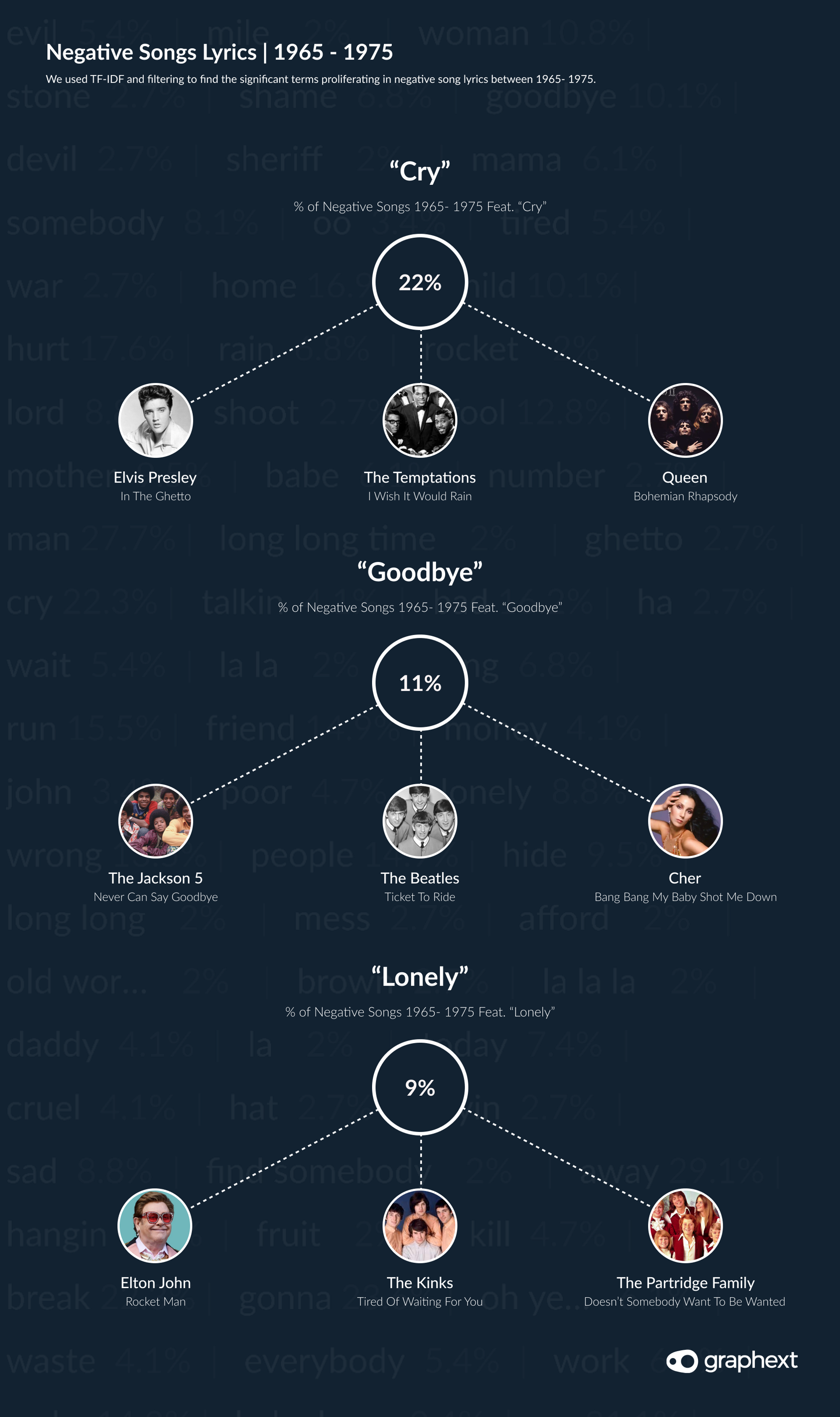
Negative Songs | 2005 - 2015
The modern era presents a very different story. Expletives appear frequently as do references to violence and drugs. For instance, 'bitch' is mentioned in only 2 songs before 1990 and in 234 songs after 1990.
Those mentioning 'bitch' in their lyrics are predominantly rappers - as is the case for other commonly appearing expletives. Popular rap music by Jay Z, Eminem and Drake among others seems to have shifted the boundaries of what is acceptable to say in a billboard hit. But the fact that more and more chart toppers are explicit rap songs speaks volumes about their popularity.
Although this seems to present an interesting reflection of modern music tastes - it is worth raising the point that these words are not always used in negative contexts. It's possible that our model has difficulty distinguishing between positive and negative associations of 'fuck' ... perhaps the same can't be said of 'kill'.
See you driving round town with the girl I love and I'm like fuck you. Oooh ooh oooh."Cee Lo Green - Fuck You | 2011
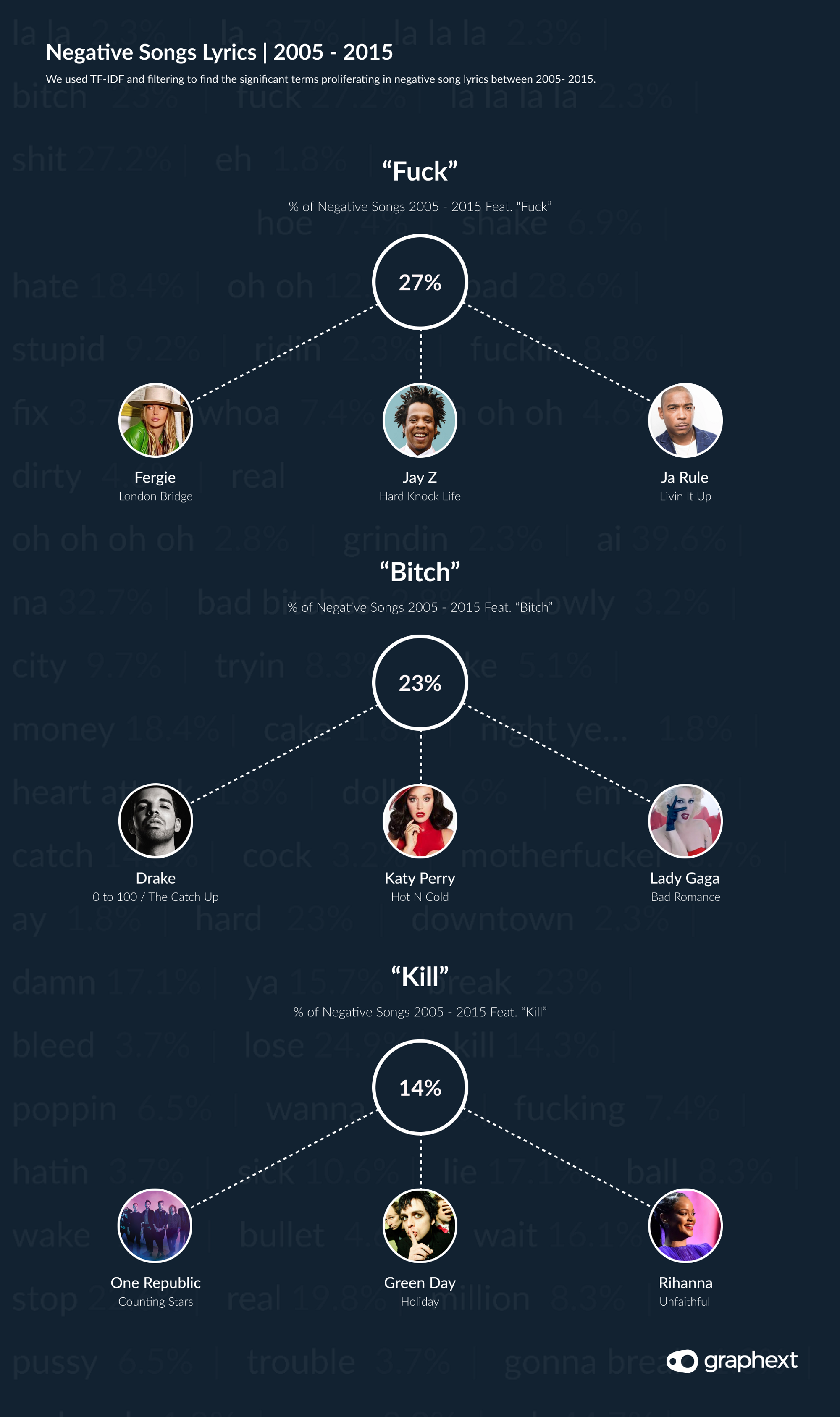
Analyzing Language with Hugging Face Models
This example of sentiment analysis gives a taste of the models from Hugging Face but barely scratch the surface of what is on offer. We've integrated Hugging Face with Graphext to make your text analysis much more powerful.
Browse the full list of models here and start deploying them by adding the code snippet below to your project recipe.
classify_text(ds.text, { "model": "cardiffnlp/twitter-xlm-roberta-base-sentiment" }) -> (ds.hf_sentiment)
When pasting the snippet into your project's code editor, make sure the input column points to the text you want to analyze. Then, add the correct model name as the "model" parameter. To learn more about adapting your project to use Hugging Face NLP models, check out this article in our technical documentation.
Special acknowledgement to the Cardiff NLP team who developed the models used in this investigation! Check out more of their models here.
On this page
- Analyzing the Sentiment of Song Lyrics
- If you want to perform a similar sentiment analysis of text - check the HOW TO - at the bottom of the article.
- Music's Most Negative Artists
- Music's Most Positive Artists
- Why Are Songs Becoming More Negative?
- Negative Songs | 1965 - 1975
- Negative Songs | 2005 - 2015
- Analyzing Language with Hugging Face Models
On this page
- Analyzing the Sentiment of Song Lyrics
- If you want to perform a similar sentiment analysis of text - check the HOW TO - at the bottom of the article.
- Music's Most Negative Artists
- Music's Most Positive Artists
- Why Are Songs Becoming More Negative?
- Negative Songs | 1965 - 1975
- Negative Songs | 2005 - 2015
- Analyzing Language with Hugging Face Models